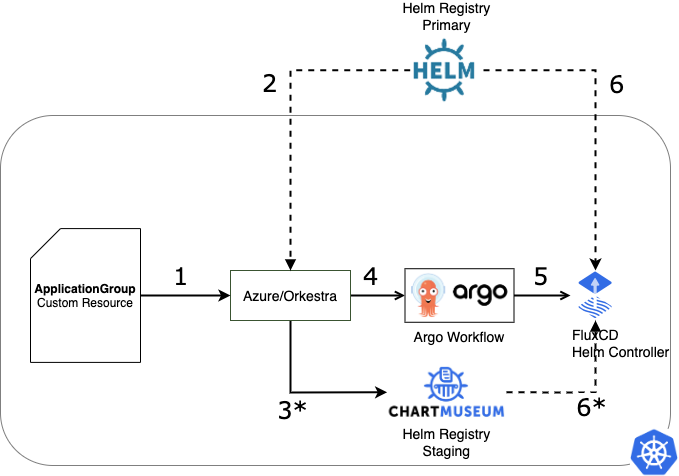|
|
||
|---|---|---|
| .github | ||
| api/v1alpha1 | ||
| assets | ||
| chart/orkestra | ||
| config | ||
| controllers | ||
| docs | ||
| examples/simple | ||
| hack | ||
| pkg | ||
| testing | ||
| testwith | ||
| .gitignore | ||
| .golangci.yml | ||
| .kind-cluster.yaml | ||
| CODE_OF_CONDUCT.md | ||
| CONTRIBUTING.md | ||
| Dockerfile | ||
| LICENSE.TXT | ||
| Makefile | ||
| PROJECT | ||
| README.md | ||
| SECURITY.md | ||
| Tiltfile | ||
| go.mod | ||
| go.sum | ||
| main.go | ||
| okteto.yml | ||
README.md
Orkestra

Orkestra is a cloud-native release orchestration and lifecycle management (LCM) platform for fine-grained orchestration a group of inter-dependent "Applications" (and their inter-dependent subcharts). An "Application" may be defined as a Helm chart or artifact, with or without subchart dependencies.
Sophisticated applications require intelligent release orchestration and lifecycle management that is not supported by Helm.
Orkestra works by generating a DAG workflow from the ApplicationGroup spec. to orchestrate the deployment and in-service upgrades of multiple applications within a Kubernetes cluster. At a finer-grain, Orkestra can also order the deployment of subcharts within an application chart by generating an embedded DAG workflow.
Orkestra leverages popular and mature open-source frameworks like Argo (Workflows), Flux Helm Operator and Chartmuseum
Use Cases 💼
Reliable (continuous) "Deployment" and in-service "Upgrades" of mission-critical applications
📱 5G Core Network Functions (NFs)📱 are 5G applications that rely on a rich ecosystem of infrastructure and PaaS (platform-as-a-service) components to be up and ready before the Network Functions can be successfully started. This establishes a hard dependency between the NFs and the infra/paas applications. Orkestra solves the dependency problem by honoring these dependencies by using a DAG workflow to deploy the infra/paas components prior to starting the NF application. This also allows for the independent lifecycle management of the infra/paas components and groups of NFs.
Architecture 🏗
To learn more about how Orkestra works see the architecture docs
Installation 🧰
For getting started you will need,
- A Kubernetes cluster
kubectl- Kubernetes clienthelm- Helm clientkubebuilder- installationcontroller-gen-GO111MODULE=on go get -v -u sigs.k8s.io/controller-tools/cmd/controller-gen@v0.5.0(this should be run from outside the Orkestra (go module) repo for it to be installed to your$GOBIN)- (optional)
argo- Argo workflow client (follow the instructions to install the binary from releases
Install the ApplicationGroup and custom resource definitions (CRDs)
Install the orkestra controller and supporting services like, Argo Workflow, Flux Helm-operator and Chartmuseum using the provided helm chart
helm install orkestra chart/orkestra/ --namespace orkestra --create-namespace
You should see resources spin up in the orkestra namespace as shown below,
> kubectl get all -n orkestra
NAME READY STATUS RESTARTS AGE
pod/orkestra-5fdbb5f777-pnbrx 1/1 Running 1 167m
pod/orkestra-argo-server-597455875f-d7ldz 1/1 Running 0 167m
pod/orkestra-chartmuseum-7f78f54f5-sq6b7 1/1 Running 0 167m
pod/orkestra-helm-operator-6498c6655-4vn2s 1/1 Running 0 167m
pod/orkestra-workflow-controller-688bc7677-k9hxm 1/1 Running 0 167m
NAME TYPE CLUSTER-IP EXTERNAL-IP PORT(S) AGE
service/orkestra-argo-server ClusterIP 10.96.78.145 <none> 2746/TCP 167m
service/orkestra-chartmuseum ClusterIP 10.96.222.214 <none> 8080/TCP 167m
service/orkestra-helm-operator ClusterIP 10.96.192.118 <none> 3030/TCP 167m
NAME READY UP-TO-DATE AVAILABLE AGE
deployment.apps/orkestra 1/1 1 1 167m
deployment.apps/orkestra-argo-server 1/1 1 1 167m
deployment.apps/orkestra-chartmuseum 1/1 1 1 167m
deployment.apps/orkestra-helm-operator 1/1 1 1 167m
deployment.apps/orkestra-workflow-controller 1/1 1 1 167m
NAME DESIRED CURRENT READY AGE
replicaset.apps/orkestra-5fdbb5f777 1 1 1 167m
replicaset.apps/orkestra-argo-server-597455875f 1 1 1 167m
replicaset.apps/orkestra-chartmuseum-7f78f54f5 1 1 1 167m
replicaset.apps/orkestra-helm-operator-6498c6655 1 1 1 167m
replicaset.apps/orkestra-workflow-controller-688bc7677 1 1 1 167m
(optional) Argo Workflow Dashboard
Start the Argo Workflow Dashboard at http://localhost:2476.
argo server --browser
...
INFO[2021-02-03T01:02:15.840Z] config map name=workflow-controller-configmap
INFO[2021-02-03T01:02:15.851Z] Starting Argo Server instanceID= version=v2.12.6
INFO[2021-02-03T01:02:15.851Z] Creating event controller operationQueueSize=16 workerCount=4
INFO[2021-02-03T01:02:15.852Z] Argo Server started successfully on http://localhost:2746
INFO[2021-02-03T01:02:15.852Z] Argo UI is available at http://localhost:2746
Features 🌟
- Dependency management - DAG-based workflows for groups of application charts and their sub-charts using Argo Workflow
- Fail fast during in-service upgrades - limits the blast radius for failures during in-service upgrade of critical components.
- Failure Remediation - rollback to last successful spec on encountering failures during in-service upgrades.
- Built for Kubernetes - custom controller built using kubebuilder
- Easy to use - familiar declarative spec using Kubernetes Custom Resource Definitions
- Works with any Continous Deployment system - bring your own CD framework to deploy Orkestra Custom Resources. Works with any Kubernetes compatible Continuous Deployment framework like FluxCD and ArgoCD.
- Built for GitOps - describe your desired set of applications (and dependencies) declaratively and manage them from a version-controlled git repository.
Developers 👩💻
Follow the development guide to get started with building and debugging Orkestra
Community 🧑🤝🧑
Connect with the Azure Orkestra community:
- GitHub issues and pull requests in this repo
- Azure Orkestra Slack: Join the Azure Orkestra Slack
Contributing 🎁
For instructions about setting up your environment to develop and extend the operator, please see contributing.md
This project welcomes contributions and suggestions. Most contributions require you to agree to a Contributor License Agreement (CLA) declaring that you have the right to, and do, grant us the rights to use your contribution. For details, visit https://cla.microsoft.com.
When you submit a pull request, a CLA-bot will automatically determine whether you need to provide a CLA and decorate the PR appropriately (e.g., label, comment). Simply follow the instructions provided by the bot. You will only need to do this once across all repos using our CLA.
This project has adopted the Microsoft Open Source Code of Conduct. For more information see the Code of Conduct FAQ or contact opencode@microsoft.com with any additional questions or comments.
Reporting security issues and security bugs
For instructions on reporting security issues and bugs, please see security.md



